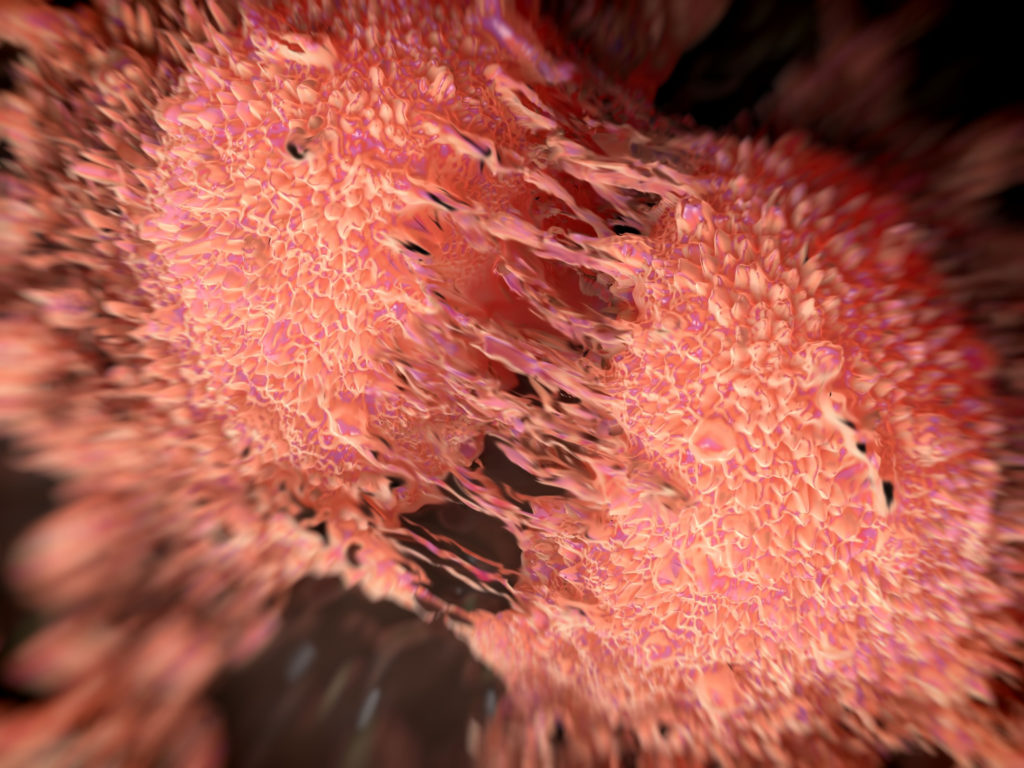Researchers in this study use scaling analysis to show that, in patients with prostate cancer who must be administered different treatments, drug resistant and metastasis-causing cells often emerge and are responsible for producing multi-drug resistant, exponentially growing tumors.

Thirteen percent of men in the United States are diagnosed with prostate cancer at some point in their lifetime, and as many as two to three percent die due to this disease. These highly unfavorable statistics regularly motivate researchers around the world to seek new discoveries and interventions to better understand and restrain prostate cancer.
A team of U.S. researchers, from Johns Hopkins University in Maryland, the National Science Foundation in Virginia, Jackson Memorial Hospital in Florida, and Columbia University Irving Medical Center and the James J. Peters Veterans Affairs Medical Center in New York, authored a study chosen to be published as the cover paper for Oncotarget’s first issue of 2021, titled: “Drug resistant cells with very large proliferative potential grow exponentially in metastatic prostate cancer.”
Exponential Growth
Multi-drug resistance is the main cause of death by cancer. The researchers in this paper explain that most patients with metastatic prostate cancer who receive androgen deprivation therapy eventually progress to a problematic stage, called castration resistant prostate cancer.
“Most metastatic cancers develop drug resistance during treatment and continue to grow, driven by a subpopulation of cancer cells unresponsive to the therapy being administered.”
At this stage, patients are no longer responsive to the drug they have been previously treated with and are then administered alternative treatments. The researchers in this study hypothesized that, after the patient’s initial treatment, their scaling analysis will show that tumor masses first decay, reach a nadir (the lowest point), and then begin on a path of exponential growth—for reasons currently unknown (though, these researchers have a couple ideas). Their scaling analysis of the clinical patient data they collected was designed to graph and measure time and levels of the prostate specific antigen (PSA) under the conditions of different treatments.
“If our hypothesis that tumors grow exponentially is correct, a straight line would be a good fit of the resulting time series with a slope equal to the growth rate of each patient’s tumor.”
Cancer Stem Cells
In an enlightening explanation, the researchers in this paper expound on the way that normal tissue homeostasis in the body is maintained. Stem cells within tissue are capable of what is known as symmetrical and asymmetrical cell division. Symmetrical cell division ensures that the number of stem cells remains constant when a stem cell is lost. Asymmetrical cell division is meant to maintain a constant number of stem cells in the tissue when all stem cells are present. The authors note that a recent discovery reported that a certain pathway drives prostate cancer cells into symmetric-only cell divisions, leading to cancer metastasis.
“Recently it was reported [8] that the WNT/ß-Catenin pathway drives prostate cancer cells into symmetric cell divisions, suggesting that these cancer cells have lost the ability to divide asymmetrically [9]. Here we show that this is also the case in patients with metastatic prostate cancer.”
They explain that this disorganized tissue structure may be responsible for tumor growth, though, the origin of these symmetrically dividing cells is currently still unclear. The researchers suggested that another potential reason for tumor growth may be due to cell mutations and epigenetic changes.
“Both mechanisms may be in play and further research is needed to characterize the architecture of the metastatic tumors and the operating cell division mechanisms.”
The Study
Researchers used scaling analysis to analyze tumor growth in patients with metastatic prostate cancer over the course of their different treatments. They chose this method of analysis because scaling analyses provide a macro-view of multi-patient data and “reveals behavior that is hard to extract from the individual patient data.”
“To extract the behavior of a physical quantity across a population of patients it is sometimes possible to scale the data of individual patients in such a way that the data from individual patients can be averaged and plotted on the same graph.”
PSA values and data from 15 randomized clinical trials were derived from the Project Data Sphere, LLC and Yale University Open Data Access Project. The researchers then averaged all patients in each treatment arm and performed scaling analysis.
“Here, using scaling analysis of clinical data of tumor burden in patients with metastatic prostate cancer, we show that the drug resistant, metastasis-causing cells (MCC) are capable of producing drug resistant, exponentially growing tumors, responsible for tumor growth as a patient receives different treatments.”
Results
“The straight line indicates that tumor growth is exponential.”
“In these advanced cancers a straight line fits the logarithm of the data showing that our initial hypothesis of exponential growth is statistically plausible since growth other than exponential would have resulted in deviation from a straight line.”
“Importantly, these non-linear functions fit the data over long periods of time, exceeding 1000 days in some patients, establishing that non-linear growth can occur over prolonged time intervals [13].”
Conclusion
“The above analysis of the data from many prostate cancer patients who received different treatments showed that the metastatic drug resistant tumors grow exponentially—this exponential growth has to be driven by symmetrically dividing cells. These cells emerge as drug resistant and eventually cause death.”
Click here to read the full scientific study, published in Oncotarget.
—
Oncotarget is a unique platform designed to house scientific studies in a journal format that is available for anyone to read—without a paywall making access more difficult. This means information that has the potential to benefit our societies from the inside out can be shared with friends, neighbors, colleagues and other researchers, far and wide.
For media inquiries, please contact media@impactjournals.com.



